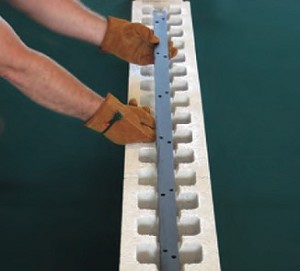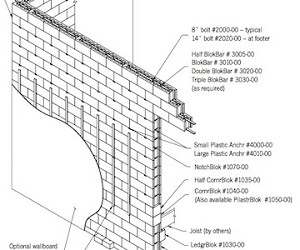Bolt-A-Blok Named in 2010 Wall Street Journal Technology Innovation Contest

The Wall Street Journal today announced Bolt-A-Blok as a runner-up in its 2010 Technology Innovation Awards in the Material and Base Technologies Category.
As of March 2009, 80 independent tests have been conducted on the strength and capabilities of Bolt-A-Blok Systems. Engineering and design analysis reveal that structures built with Bolt-A-Blok meet or exceed Dade County hurricane specifications and California seismic specifications.
In addition, Bolt-A-Blok successfully passed International Concrete Committee (ICC) requirements.
“Bolt-A-Blok is an evolutionary product as it modernizes construction principles that have been in place for hundreds of years, yet it’s also revolutionary with its patented unitized post-tensioned, mechanically fastened connection system,” the company stated. “It has the compressive (crush) strength of concrete and the tensile (pull) strength of steel at a relatively lower cost.”
“Globally there is a desperate and immediate need for temporary and permanent housing that can be quickly built onsite,” said Roger Marsh, Chairman and Inventor of Bolt-A- Blok. “We offer a solution that replaces conventional building systems which are historically expensive, marred by delays, require skilled labor and do not sustain hurricanes, tornadoes and earthquakes.”
Bolt-A-Blok — promoted as “fastener, stronger, more economical and environmentally friendly” — provides a building system for disaster relief as well as residential and commercial structures.
“Bolt-A-Blok answers the need for simple, fast and strong systems that can be made with easy instructions and without complex equipment,” the company stated. “It uses no water, has immediate occupancy (no cure time) and resists hurricanes and earthquakes.”
“Bolt-A-Blok combines the strength of steel and concrete (the strongest materials available) to create a ‘ready-built system.’”
Existing residential and commercial markets also find Bolt-A-Blok attractive because of the reduced build times, since Bolt-A-Blok reportedly needs no cure time as well as significant improvements to labor efficiencies and overall structural strength.
Currently Bolt-A-Blok is working to assist disaster relief efforts with NGOs (Non-Government Organizations) to provide earthquake and hurricane resistant houses and buildings that will be built by local residents from complete kits. Bolt-A-Blok recently shipped and manufactured products in the Dominican Republic, ready to assist in the efforts to rebuild Haiti.
In addition, Bolt-A-Blok has completed projects for the following customers: Make It Right Foundation (founded by actor and philanthropist Brad Pitt); Stellar Construction (providers of design, engineering, construction and mechanical services worldwide); Habitat for Humanity; and ABC Extreme Home Makeover.
In the U.S., current licensing and multi-state distribution agreements are in place with County Materials Corporation (more than 25 locations throughout the Midwestern U.S.) and ABC Concrete (nine locations serving part of the Southern U.S.), with many more expected in the coming weeks.
Alexandria, IN-based Bolt-A-Blok filed its first patent application in November 2005. Bolt-A-Blok has a US patent allowed and foreign patents granted.
The company was officially founded in July 2006 by Roger Marsh with a Research and Development Lab located in Alexandria, Indiana. The company established its headquarters in January 2009 in Madison County, Indiana. Five U.S. and 43 foreign patents are pending, two trademarks are registered, initial third party testing is complete and profits from sales have begun. ©2010 GlobalFastenerNews.com
Editor’s Note: The Wall Street Journal received 597 applications from companies, organizations and individuals in 30 countries. Journal editors reviewed the entries and forwarded approximately 275 to a panel of judges from research institutions, venture-capital firms and other companies. The judges assessed the applications on three criteria: Does the innovation break with conventional ideas or processes in its field? Does it go beyond marginal improvements on something that already exists? Will it have a wide impact on future technology in its field or in other fields?
Related Links:





There are no comments at the moment, do you want to add one?
Write a comment